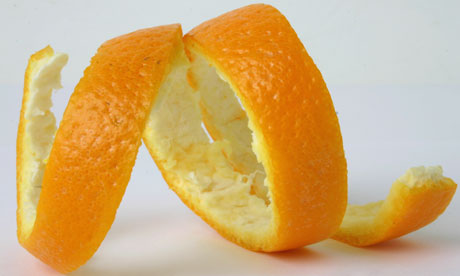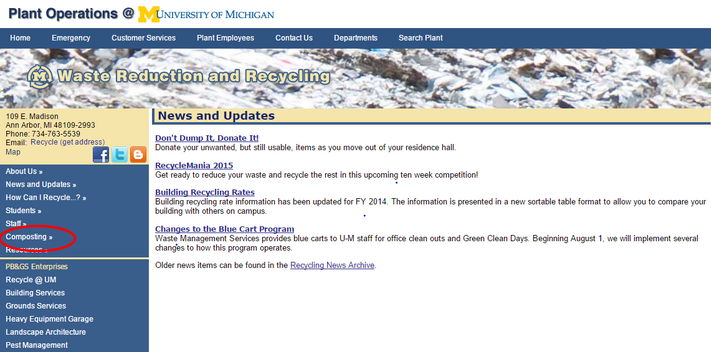At a campus this large, it can be hard to navigate all of the different sustainability efforts. Hopefully you've seen Rufus around by now, but do you know which office Rufus works for? Have you heard of the Planet Blue Student Leaders? Do you know they are a part of of the Graham Sustainability Institute? Do you see how this can get confusing? I'm here to clear up the fuzziness.
Operational Offices
Let's start with some of the offices that make sustainability happen here on campus, which include Parking and Transportation, Grounds, Planet Blue Operations Teams, Energy Management, and others. In order to keep this blog post to a readable length, I have decided to focus on the Office of Campus Sustainability and the Waste Reduction and Recycling Office.
The Office of Campus Sustainability (OCS), is the go-to office for general sustainability questions on campus. Managed by Andy Berki and directed by Terry Alexander, OCS leads a number of impactful sustainability initiatives on campus. Every year, the office organizes a Sustainability Town Hall, at which yours truly presented in 2014. They are also responsible for the E-Waste Recycling Event that has occurred each spring beginning in 2008. In collaboration with Central Student Government, OCS has helped put up Water Refill Stations at over 100 locations across campus. The Sustainable Lab Recognition Program and the Sustainable Workplace program are also run by OCS. These programs aim to certify offices and laboratories on campus as sustainable through an online self-assessment, an on-site visit from an OCS Sustainability Representative, and an assessment of the workplace’s sustainability rating and ways to improve. You can contact OCS at ocs_contact@umich.edu.
The Waste Reduction and Recycling Office (WRRO), within Plant Operations, oversees recycling, waste reduction and composting programs. This office is staffed by Tracy Artley, Plant Building and Grounds Services sustainability programs coordinator, and Alison Richardson, recycling coordinator. WRRO is currently administering the RecycleMania program, in which campus competes to see who can reduce their waste and recycle the most! See our RecycleMania blog post for more information about this competition. WRRO also organizes Rufus Mondays, which is when the university's recycling mascot, Rufus the Recycler, goes out on campus and engages with students! You can find Rufus and his wrangler on campus each Monday between 10:30am and noon! If you have any questions about recycling or composting on campus, email recycle@umich.edu!
Quick note: You've probably seen this logo around campus:
There is no "Planet Blue" office, rather Planet Blue is the brand that is associated with all the sustainability-related initiatives occurring across operations, academics and research at U-M.
Academic Office
Another important sustainability office on campus is the Graham Sustainability Institute. Directed by Don Scavia, Graham runs an Education Center, a Water Center, Climate Center, and an Integrated Assessment Center. A number of really cool research projects are being conducted by these centers; the Water Center, for example, is currently doing research on Lake Erie’s algal blooms. of The Education Center runs the Planet Blue Student Leader Program, the Planet Blue Ambassador Program, and the Planet Blue Student Innovation Fund. The Planet Blue Student Leader program helps to train students living University Housing to be sustainability spokespeople for their dorms. The Planet Blue Ambassador Program aims to train all members of the U-M community to be ambassadors for sustainability here at U-M. Lastly, the Planet Blue Student Innovation Fund funds student-led sustainability projects up to $50,000. You can email Graham at graham-institute@umich.edu.
Student-led Organizations
 There are countless student groups working toward a more sustainable campus and world. The Student Sustainability Initiative (SSI) is a board of five students dedicated to bringing together all of the various sustainability-related student groups at their monthly roundtables, which typically occur the third or fourth Tuesday of every month. The next SSI Roundtable is on February 24th from 6:30 p.m. to 8 p.m. They also manage the Zero Waste Event Grant Program, through which they provide funding for any student group wanting to make their events Zero Waste. They also oversee a small scale grant funding program which awards grants of up to $1,000 for individuals or teams working on environmental projects on campus.
There are countless student groups working toward a more sustainable campus and world. The Student Sustainability Initiative (SSI) is a board of five students dedicated to bringing together all of the various sustainability-related student groups at their monthly roundtables, which typically occur the third or fourth Tuesday of every month. The next SSI Roundtable is on February 24th from 6:30 p.m. to 8 p.m. They also manage the Zero Waste Event Grant Program, through which they provide funding for any student group wanting to make their events Zero Waste. They also oversee a small scale grant funding program which awards grants of up to $1,000 for individuals or teams working on environmental projects on campus.
Among the many other student groups on campus dedicated to sustainability are the Greek Life Sustainability Team (GLIST), the LSA TREEs Sub Committee of the Student Life Committee (Taking Responsibility for the Earth and Environment), the Program in the Environment (PitE) Club, Net Impact Undergrad Chapter, HaYerukim, the PermaCulture Design Team, BLUELab, MHEAL, the Solar Car Team, A2Share, Ann Arbor Soup, Divest and Invest Campaign, Friends of the Campus Farm, Kill-a-Watt, Leaders for Environmental Awareness and Discussion, Solar Spring Break, Food Recovery Network, Student Food Co, Students for Clean Energy, Sustainability Without Borders, etc. You can find out more about these groups on Maize Pages!
That's all, folks! I hope I cleared up any confusion. If you have any further questions, email sarahcp@umich.edu and either I will find an answer for you or direct you to someone who can help!





















